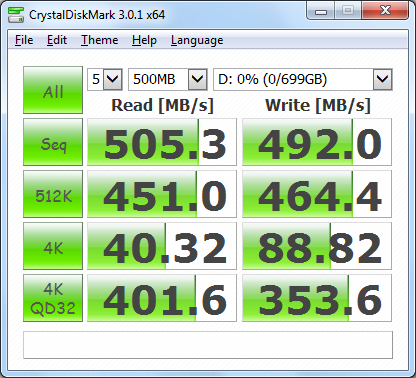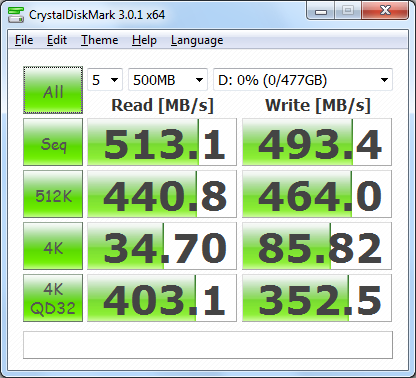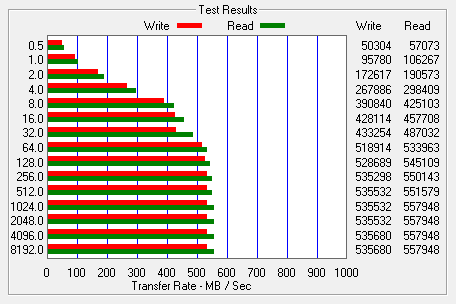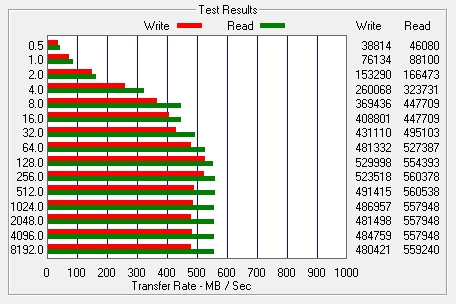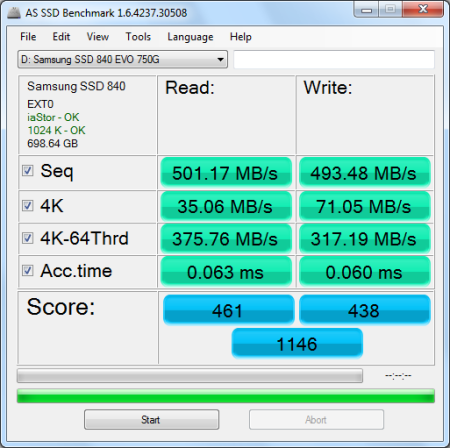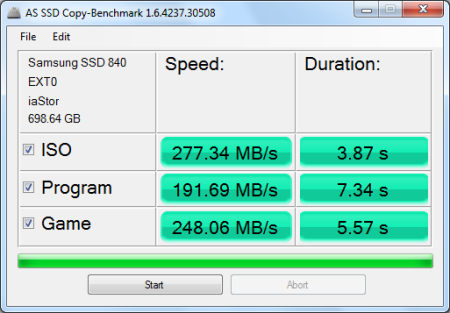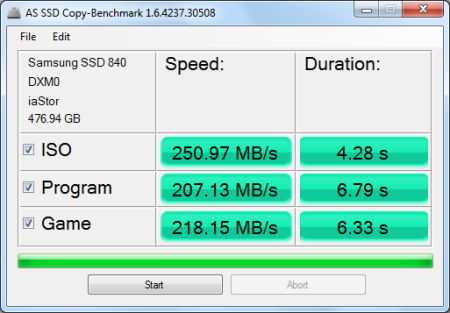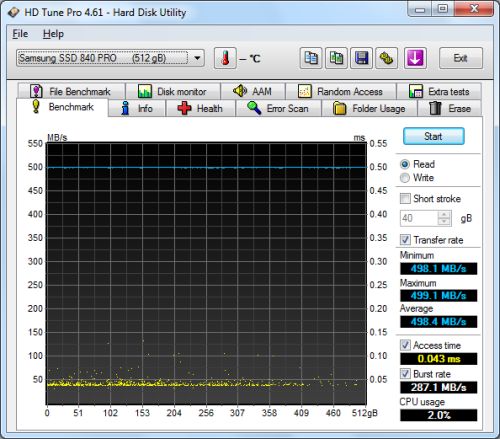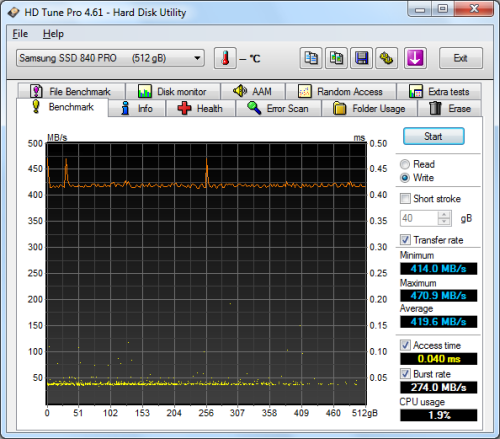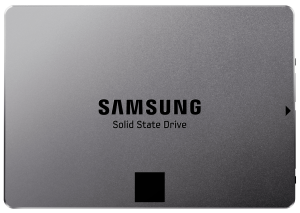

Model: Samsung SSD 840 EVO Series 750GB Solid State Drive
Manufacturer: Samsung Electronics
Provided By: Samsung America
Samsung Electronics has been a leader in the electronics industry for more than 30 years. Since the introduction of their first television in 1970, this Korean company has grown to become one of the world's leading electronics manufacturers, offering everything from tiny semiconductors to large home appliances. Samsung is no stranger to the storage industry either. Along with an assortment of DVD and Blu-ray Disc drives, the company offers both hard drive and flash based storage solutions for the portable and desktop computer markets
Like many other manufacturers, Samsung has set its sights on the growing solid-state drive (SSD) market. Last fall, the company introduced its 840 Series SSDs. Designed and built completely in-house, the SSD 840 and SSD 840 Pro were powered by Samsung's own triple-core MDX controller and featured a SATA 6GB/s interface, specially-engineered wear-leveling and garbage collection algorithms and up to 512MB of cache. The main difference between the two was that the SSD 840 used Samsung's new 3-bit/cell MLC NAND, which is often referred to as TLC NAND. This high-density NAND was more affordable than the 2-bit/cell MLC NAND found in the SSD 840 Pro, but there was a bit of a trade off in regards to endurance (program/erase cycles) and performance.
Samsung has now launched the SSD 840 EVO. Unveiled at the company's annual SSD Global Summit, the drive is powered by Samsung's new MEX controller that is faster, yet more energy efficient, than the MDX controller found in the SSD 840 and SSD 840 Pro. The SSD 840 EVO is also available with up to 1TB of Samsung's second generation 3-bit/cell MLC NAND. To overcome the slow write speeds typically associated with this type of NAND flash, Samsung has increased the size the DRAM cache and implemented an innovative write acceleration algorithm called TurboWrite, which creates a high-performance write buffer in the SSD. Along with TurboWrite, the SSD 840 EVO supports Samsung's new RAPID (Real-time Accelerated Processing of I/O Data) technology. By using free PC memory as a cache, RAPID can push the performance of the SSD beyond the limits of the current SATA specification.

The SSD 840 EVO is available in a wide range of capacities from 120GB up to a massive 1TB. For this review, Samsung sent us the 750GB version of the drive which is capable of delivering up to 540 MB/s sequential read and 520 MB/s sequential write speeds as well as up to 98,000 random read and 90,000 random write IOPS.
| Samsung SSD 840 EVO Series 750GB Solid State Drive | |||||||||||||||||||||||||||||||||||||||||||||||||
General Specifications
Performance
Reliability
Power Consumption
Environmental
Dimensions and Weight
Other Features
|
Needless to say, this is only a taste of what the SSD 840 EVO has to offer. To give you an idea of what to expect, we'll take a closer look at Samsung's new SSD and then see how well it performs. Does the SSD 840 EVO have what it takes? Can it deliver the performance and features that we've come to expect from Samsung? Keep reading as we find out.
The SSD 840 EVO comes in a small black box. While there aren't a lot of details on the front, the back of the box lists many of the drive's features as well as its specifications. Inside, you'll find the SSD, warranty statement, installation guide, software and manual CD and a couple of "Samsung SSD Activated" stickers for your computer's case.

Physical Features:
Like Samsung's previous SSDs, the SSD 840 EVO is very well constructed. The drive's outer casing is made entirely out of aluminum and is very strong and lightweight. Instead of the black and orange color scheme found on the SSD 840 and SSD 840 Pro, the SSD 840 EVO is primarily dark gray in color. The Samsung logo and square have also been "blacked out", which adds to the drive's already stealthy look.


Upon opening the case, I was a bit surprised to see how small the SSD 840 EVO's PCB was. Instead of using a regular size PCB, Samsung has placed a 1.8" form factor PCB inside of a 2.5" case.

The SSD 840 EVO uses Samsung's new S4LN045X01-8030 controller chip. Developed entirely in house, this proprietary, triple-core MEX controller excels at multi-tasking. Based on an ARM Cortex R4 (400MHz) controller, its three CPU cores can execute multiple instructions such as reading data, writing data and optimization.


For the 750GB version of the SSD 840 EVO, Samsung used their own 19nm Toggle Mode MLC NAND flash chips. Looking at the pictures above, you can see that there are four 128GB (K90KGY8S7M-CCK0) chips on the front and four 64GB (K9CHGY8S5M-CCK0) chips on the back of the PCB. The drive also has a single 1TB K4P8G304EB-FGC2 LPDDR2 DRAM memory chip that is used for caching.
The Samsung Magician software is designed to help users easily manage the health and performance of their Samsung SSD. From the main screen, users can check the health of their drives and view information like the serial number, firmware, capacity and the total bytes written. This screen also shows whether or not AHCI mode has been activated as well as the speed of the SATA interface.

Magician also gives users the ability to benchmark their drives and optimize the performance by forcing TRIM and Garbage Collection to run. In addition to this, users can download and apply firmware updates using the software.
Most operating systems are optimized for traditional hard drives. The OS Optimization menu provides options that help you configure your OS to work best with your SSD. Additionally, the Over Provisioning menu gives you the ability to optimize the performance and lifespan of your drive by resizing the partitions.
The Secure Erase feature provides the option to delete all data on an SSD in a way that it can never be recovered, restoring the drive to its original performance. Magician gives you the option to do this from within Windows. Otherwise, if your SSD is in a frozen state, you can create a bootable USB drive, CD or DVD.

Magician 4.2 introduces a new feature called RAPID (Real-time Accelerated Processing of I/O Data). When enabled, RAPID mode enhances the performance of the SSD 840 EVO by processing data on a system level through the use of free PC memory (DRAM) as a cache. Depending on your PC memory, you can expect higher performance and more efficient command processing, which improves with repeated tasking

In order to deliver the fastest and the most reliable user experience, RAPID mode focuses on improving the random performance with low queue depth and small size data. When frequently used (hot) data is recognized, it can also enhance the sequential performance. As Samsung points out though, improvement can vary depending on user scenarios, but at least in our case, we saw an increase of more than 57,000 points in the PCMark Vantage HDD test suite.

The test system used in this review was an HP 8200 Elite. The computer came equipped with an Intel Core i5-2400 CPU, 4GB of DDR3 1333MHz memory, Seagate Barracuda 7200.12 ST3250312AS 250GB SATA 6 Gb/s hard drive, NVIDIA Quadro FX580 512MB PCIe graphics card and an Intel 82579-LM gigabit network card. For the operating system, I installed a fresh copy of Windows 7 Enterprise.
To test the performance of Samsung's 750GB SSD 840 EVO, I ran a series of benchmarks using CrystalDiskMark 3.0.1, HD Tach RW 3.0.4.0, ATTO Disk Benchmark 2.46, AS SSD, HD Tune Pro 4.61, Anvil's Storage Utilities and Iometer. For comparison, I've also included test results from the Seagate SSD 600, SanDisk Extreme II, OCZ Vector, Plextor PX-256M5Pro Xtreme, Samsung SSD 840 Pro, Samsung SSD 840, Kingston Ultra Plus, OCZ Vertex 4, OCZ Agility 4, Kingston SSDNow V300 and Kingston HyperX 3K.

As I mentioned earlier, the SSD 840 EVO is based on Samsung's latest MEX (S4LN045X01-8030) controller chip. Looking at the screenshot above, you can see that it performs equally well with both incompressible (0%) and compressible (100%) data.
CrystalDiskMark 3.0.1:
First, I ran a few quick tests using CrystalDiskMark. This benchmark tool measures the performance of a storage device by testing its sequential read and write speeds as well as its random read and write speeds using blocks 512K and 4K in size.
According to Samsung, the 750GB SSD 840 Evo is capable of reading at 540 MB/s and writing at 520 MB/s when connected to a SATA 6 Gb/s port. The drive performed well, came up a bit short of these numbers in CrystalDiskMark's sequential read and write speed tests. With RAPID mode enabled, these numbers increased by more than tenfold. Looking at the screenshot above, you can see that the SSD 840 Evo was able to read at 5,045 MB/s and write at a blazing 5,255 MB/s.
HD Tach RW 3.0.4.0:
Next, I used HD Tach to test the SSD 840 EVO's read, write and burst speeds as well as its seek times and CPU usage.

Samsung SSD 840 Evo 750GB

Samsung SSD 840 Evo 750GB (RAPID Mode)
Looking at the screenshot above, you can see that the SSD 840 EVO had average read and write speeds of 430.2 MB/s and 414.1 MB/s respectively, as well as a burst speed of 378.9 MB/s. This time around, RAPID mode had very little effect on the drive's performance. Most likely, this is due to the way HD Tach bypasses the file system when performing its read and write tests.
ATTO Disk Benchmark 2.46:
I also used ATTO Disk Benchmark to test the SSD 840 EVO's sequential read and write speeds. The tests are run using blocks ranging in size from 0.5KB to 8192KB and the total length set to 256MB.
When tested with ATTO, the SSD 840 EVO's read speeds topped out at about 558 MB/s and its write speeds at 535 MB/s. With RAPID mode enabled, the read and write speeds were all over the place, but for the most part, it was a considerable improvement.
AS SSD:
AS SSD is a relatively new benchmark designed specifically for solid state drives. The application contains five synthetic tests used to determine the sequential and random read and write performance of a drive.
AS SSD also includes a copy benchmark. This test copies an ISO (two large files), program (many small files) and game (small and large files), returning the speed and duration of each.
HD Tune Pro 4.61:
Next, I ran a series of tests using HD Tune Pro. This hard disk utility measures a drive's performance by testing its sequential read and write speeds as well as its access time, burst rate and CPU usage. For this review, I'm also going to use it to benchmark the SSD 840 EVO's random read and write speeds, random access times and the number of operations per second.
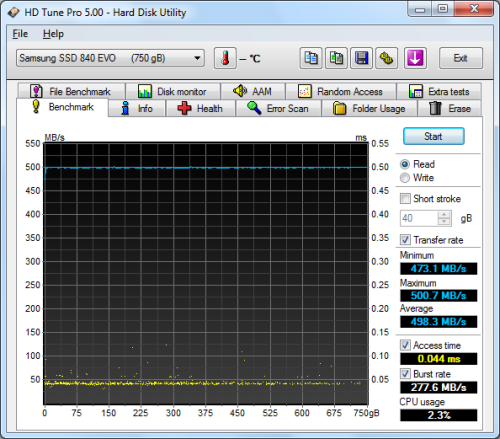 Samsung SSD 840 Evo 750GB - HD Tune Read Benchmark |
 Samsung SSD 840 Evo 750GB (RAPID Mode) - HD Tune Read Benchmark |
 Samsung SSD 840 Evo 750GB - HD Tune Write Benchmark |
 Samsung SSD 840 Evo 750GB (RAPID Mode) - HD Tune Write Benchmark |
The SSD 840 EVO performed very well when benchmarked with HD Tune. The drive had average read and write speeds of 498.3 MB/s and 411.9 MB/s, respectively, and a burst rate of 277.6 MB/s when reading. Surprisingly, RAPID mode had very little impact on the drive's read speed. However, it was slightly faster when writing.
 Samsung SSD 840 Evo 750GB - HD Tune Random Access Read |
 Samsung SSD 840 Evo 750GB (RAPID Mode) - HD Tune Random Access Read |
 Samsung SSD 840 Evo 750GB - HD Tune Random Access Write |
 Samsung SSD 840 Evo 750GB (RAPID Mode) - HD Tune Random Access Write |
The SSD 840 EVO didn't disappoint when doing random reads and writes. When reading 4KB blocks, it reached 20,653 IOPS and had an average speed of 80.676 MB/s. The drive was slightly faster when writing, reaching 21,296 IOPS with an average speed of 83.190 MB/s. As you can see, RAPID mode gave the SSD 840 EVO's random read and write performance a considerable boost. With it enabled, the drive reached 148,875 random read IOPS and 137,268 random write IOPS.
Anvil's Storage Utilities:
Anvil's Storage Utilities is another new benchmark designed with SSDs in mind. The standard storage benchmark measures a drive's performance by testing its transfer speeds, access times and IOPS.

Samsung SSD 840 Evo 750GB

Samsung SSD 840 Evo 750GB (RAPID Mode)
Iometer:
Lastly, I ran a series of tests using Iometer. This tool can be configured to benchmark a number of things. In this case, I used it to measure the SSD 840 EVO's read and write speeds and the number of operations per second. The tests were run using random bytes and a queue depth of 3.

The 512GB SSD 840 EVO's performance was very similar to what we saw in our other tests. The drive was able to read at 526.68 MB/s and write at 460.35 MB/s. With RAPID mode enabled, its read and write speeds jumped to 564.38 MB/s and 641.56 MB/s, respectively.

The SSD 840 EVO also performed very well when doing random reads and writes. In our tests, the drive was able to read at 152.69 MB/s and write at 334.88 MB/s. This by itself is impressive, but with RAPID mode enabled, its random write speed jumped to 357.64 MB/s.

According to Samsung, the 750GB SSD 840 EVO is capable of 98,000 IOPS when reading and 90,000 IOPS when writing 4K blocks. In our tests, the drive reached 39,087 random read IOPS and 85,730 random write IOPS. RAPID mode had little impact on the SSD 840 EVO's random read performance. However, with it enabled, the drive was able to reach 91,557 random write IOPS.
TRIM Performance:
While SSDs offer many benefits, there are some downsides to using flash memory. One of the biggest issues people run into is performance degradation. Over time, an SSD will run out of fresh blocks and will have to write over data the file system has marked as deleted. This procedure is very complicated and can slow an SSD's write speeds considerably.
To fix this problem, most manufacturers have added TRIM support to their SSDs. The TRIM command allows an operating system, such as Windows 7, to tell an SSD which data blocks are no longer in use. Using this information, the drive pro-actively erases these blocks and adds them to the free block pool.

To test the SSD 840 EVO's TRIM function, I first put the drive in a "dirty" state. I used Iometer to fill the entire drive and then ran a random write test for 30 minutes. Looking at the screenshot below, you can see that the SSD 840 EVO's average read and write speeds dropped to 253.1 MB/s and 41.0 MB/s, respectively.
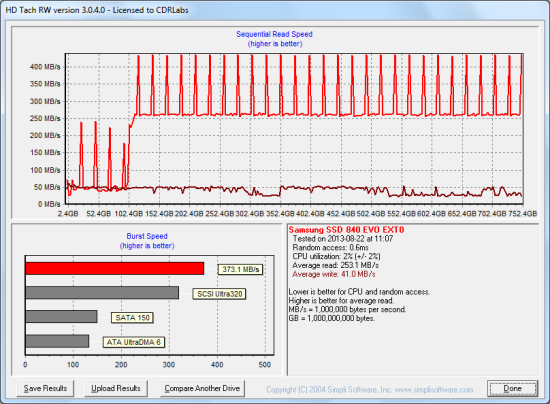
Samsung SSD 840 EVO 750GB - Dirty
To see how well the SSD 840 EVO could recover, I let the computer sit for a few hours and then reran the test. The drive's average write speed climbed up to 406.1 MB/s. However, its read speed still lagged a bit behind, averaging out at 280.5 MB/s.
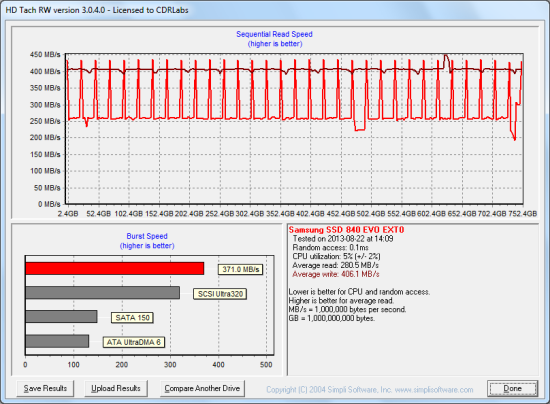
Samsung SSD 840 EVO 750GB - After Trim
Lastly, I used Samsung's SSD Magician software to perform a secure erase of the SSD 840 EVO. With the drive wiped clean, it had average read and write speeds of 412.9 MB/s and 401.6 MB/s, respectively.
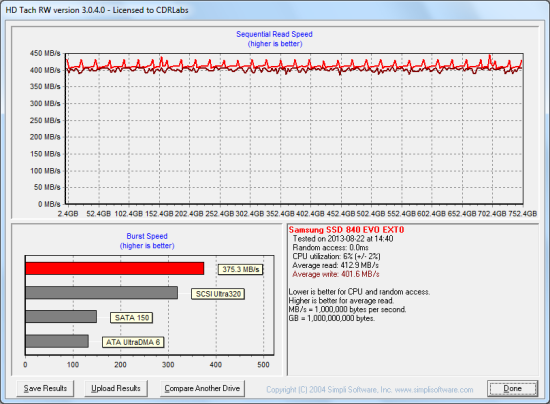
Samsung SSD 840 EVO 750GB - Secure Erase
Final Thoughts:
Samsung has knocked another one out of the park with its new 840 EVO Series SSD. Designed and built entirely in-house, this ultra-slim, high-capacity drive combines Samsung's triple-core MEX controller with their second generation 3-bit MLC NAND flash. Add in a massive DRAM cache and Samsung's new TurboWrite technology and you have a drive capable of some pretty impressive performance. In our sequential read and write tests, the 750GB version of the SSD 840 EVO was able to read at speeds as high as 560 MB/s and write at speeds in excess of 490 MB/s. The drive also did very well in our random write tests, producing more than 85,000 IOPS at low queue depths. While a big improvement over the SSD 840, these numbers aren't as high as what we saw with the SSD 840 Pro. However, with RAPID mode enabled, the performance can be boosted beyond what a single, SATA SSD is normally capable of.
The best thing about the SSD 840 EVO is the price. With the performance and features the drive offers, Samsung could have set the price somewhere in between the SSD 840 and SSD 840 Pro and no one would have batted an eye. Instead, they've priced it in line with the SSD 840, making it one of the best bangs for your buck, especially if you're looking for a high-capacity drive.
The SSD 840 EVO is available now in 120GB, 250GB, 500GB, 750GB and 1TB capacities. Prices on Amazon.com currently range from $109 up to $650, with the 750GB version reviewed here going for about $529.

Highs:
- Available in 120GB, 250GB, 500GB, 750GB and 1TB capacities
- Features RAPID mode and TurboWrite technology
- Excellent sequential read and write speeds
- Very good random read and write performance
- Performs equally well with compressible and incompressible data
- Good looking, ultra-slim design
- SATA 6Gb/s interface
- Large SDRAM cache
- Supports TRIM, garbage collection and wear leveling
- AES 256-bit full disk encryption
- Includes SSD Magician software and Data Migration Tool
- 3 year warranty
Lows:
- Samsung's 3-bit MLC NAND is not as durable as 2-bit MLC NAND







